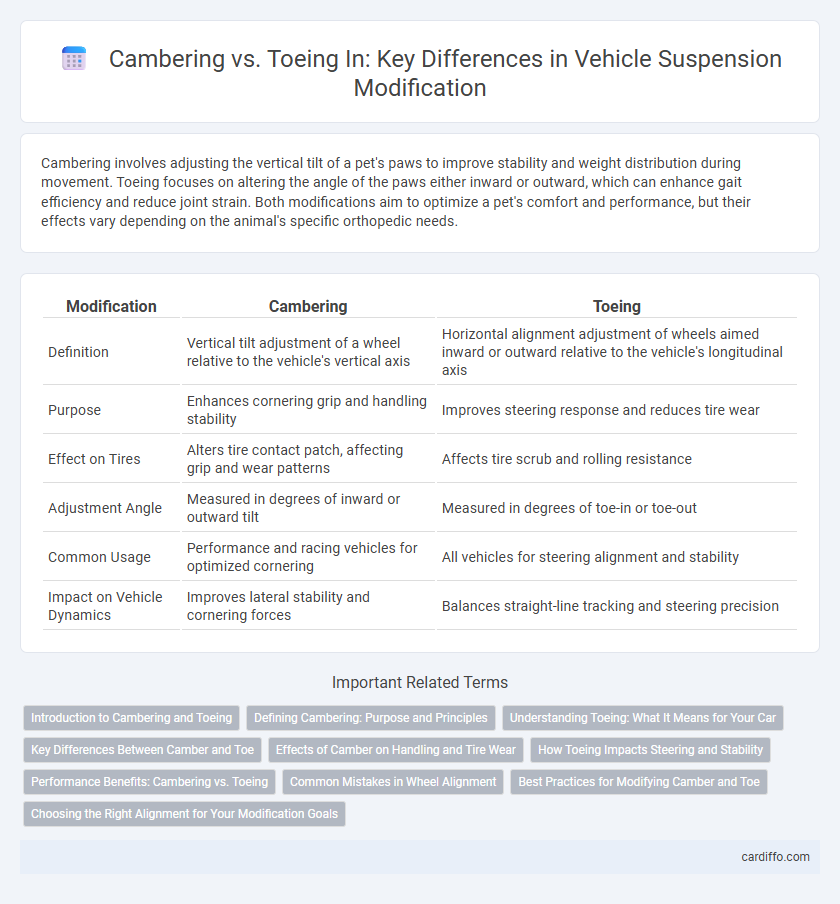Cambering involves adjusting the vertical tilt of a pet's paws to improve stability and weight distribution during movement. Toeing focuses on altering the angle of the paws either inward or outward, which can enhance gait efficiency and reduce joint strain. Both modifications aim to optimize a pet's comfort and performance, but their effects vary depending on the animal's specific orthopedic needs.
Table of Comparison
| Modification | Cambering | Toeing |
|---|---|---|
| Definition | Vertical tilt adjustment of a wheel relative to the vehicle's vertical axis | Horizontal alignment adjustment of wheels aimed inward or outward relative to the vehicle's longitudinal axis |
| Purpose | Enhances cornering grip and handling stability | Improves steering response and reduces tire wear |
| Effect on Tires | Alters tire contact patch, affecting grip and wear patterns | Affects tire scrub and rolling resistance |
| Adjustment Angle | Measured in degrees of inward or outward tilt | Measured in degrees of toe-in or toe-out |
| Common Usage | Performance and racing vehicles for optimized cornering | All vehicles for steering alignment and stability |
| Impact on Vehicle Dynamics | Improves lateral stability and cornering forces | Balances straight-line tracking and steering precision |
Introduction to Cambering and Toeing
Cambering involves adjusting the vertical tilt of the wheels to enhance handling and tire grip, often measured in degrees to optimize vehicle performance. Toeing refers to the angle at which wheels point inward or outward relative to the vehicle's centerline, influencing steering response and tire wear. Both cambering and toeing adjustments are critical in suspension tuning for improving traction, stability, and overall driving dynamics.
Defining Cambering: Purpose and Principles
Cambering involves adjusting the vertical angle of a vehicle's wheels to improve tire contact and handling performance, typically measured as the tilt of the wheel from vertical. Its primary purpose is to optimize grip during cornering by increasing the tire's contact patch, reducing uneven tire wear and enhancing vehicle stability. Proper camber settings balance between maximizing lateral traction and maintaining straight-line tire life, making it a critical parameter in suspension tuning.
Understanding Toeing: What It Means for Your Car
Toeing refers to the angle at which the wheels point inward or outward when viewed from above, directly impacting tire wear and vehicle handling. Incorrect toe settings can cause uneven tire wear, reduce fuel efficiency, and impair steering response, making precise adjustment critical for optimal performance. Monitoring and adjusting toe alignment ensures smoother rides, enhanced stability, and extended tire lifespan.
Key Differences Between Camber and Toe
Camber refers to the vertical tilt of the wheels relative to the road surface, affecting tire contact and handling stability, whereas toe describes the horizontal angle of the wheels, influencing steering response and tire wear. Camber angles impact cornering grip by altering the tire's contact patch during turns, while toe settings determine vehicle straight-line tracking and tire scrub. Precise adjustment of camber and toe is essential for optimizing vehicle performance and extending tire life.
Effects of Camber on Handling and Tire Wear
Cambering alters the wheel's vertical angle, enhancing cornering grip by maximizing tire contact during turns, which improves handling performance. Negative camber increases lateral grip but can accelerate inner tire wear, especially on the inside edges. Proper camber adjustment balances handling benefits with tire longevity, reducing uneven tire wear patterns.
How Toeing Impacts Steering and Stability
Toeing significantly affects vehicle steering response and overall stability by altering wheel alignment angles relative to the longitudinal axis. Positive toe-in improves straight-line stability by reducing tire scrub during cornering, while excessive toe-out enhances turn-in responsiveness but may cause instability at high speeds. Precise toe adjustment balances steering precision with tire wear, enhancing handling performance and safety.
Performance Benefits: Cambering vs. Toeing
Cambering improves cornering stability by optimizing tire contact patches, resulting in enhanced grip and reduced understeer during high-speed turns. Toeing adjustments influence straight-line stability and tire wear by aligning wheel angles to minimize slip and improve responsiveness. Performance benefits of cambering primarily target lateral handling, while toeing adjustments refine directional control and vehicle precision.
Common Mistakes in Wheel Alignment
Common mistakes in wheel alignment often involve improper cambering, where incorrect angles cause uneven tire wear and reduced handling performance. Toe misadjustment frequently leads to accelerated tire wear and compromised vehicle stability, especially during cornering. Ensuring precise camber and toe settings is essential for optimal tire longevity and safe driving dynamics.
Best Practices for Modifying Camber and Toe
Adjusting camber and toe angles requires precise measurements using alignment tools to enhance vehicle handling and tire longevity. Best practices include setting camber within the manufacturer's recommended range to prevent uneven tire wear and adjusting toe angles to improve directional stability without inducing excessive tire scrub. Regularly verifying alignment after modifications ensures optimal performance and safety on various driving conditions.
Choosing the Right Alignment for Your Modification Goals
Selecting the appropriate alignment modification between cambering and toeing depends on your vehicle's performance goals and handling preferences. Camber adjustments improve cornering grip by altering tire contact patches, while toe settings influence straight-line stability and responsive steering. Understanding the impact of each alignment type helps optimize traction, tire wear, and overall driving dynamics for your specific modification objectives.
cambering vs toeing Infographic

 cardiffo.com
cardiffo.com